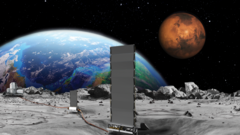NASA's Fission Surface Power Project aims to fast-track the construction of a nuclear reactor on the Moon by 2030, according to various reports. This initiative is part of a larger strategy to establish a permanent human presence on the lunar surface as the U.S. seeks to maintain its lead in space exploration amidst competition from China and Russia. Politico highlighted comments from NASA's acting head, who warned of foreign powers potentially establishing exclusive zones on the Moon if the U.S. does not proceed strategically.
The urgency expressed by U.S. transport secretary Sean Duffy underscores the need for rapid advancements in nuclear technology to support long-term lunar habitats and secure national interests in space. Duffy has solicited proposals from commercial entities to create a reactor capable of generating at least 100 kilowatts of power, a modest figure compared to a typical wind turbine’s output of 2-3 megawatts.
The concept of a lunar nuclear reactor is not novel. NASA awarded contracts to develop reactor designs in 2022, while China and Russia announced their intent to construct an automated nuclear power station on the Moon by 2035. Many experts assert that nuclear power is essential for consistent energy supply during the lunar day-night cycle, which consists of two weeks of sunlight followed by two weeks of darkness.
Dr. Sungwoo Lim from the University of Surrey emphasizes that to sustain any crewed lunar habitat, a substantial power generation capability exceeding megawatts will be necessary. NASA's Artemis program, aimed at returning humans to the lunar surface by 2027, is suggested to reflect the infrastructure needs for supporting this endeavor, given that sufficient funding and commitment are provided.
Concerns regarding the safety of launching radioactive materials into space have also been raised, outlining the stringent regulations surrounding such operations. The recent announcement from Duffy follows a significant budget cut of 24% to NASA through 2026, which has left many critical programs vulnerable, including the Mars Sample Return mission.
While competition in space exploration can drive innovation, some scientists worry that a strong focus on national interests may overshadow the spirit of collaboration that is vital for the exploration of our solar system. Dr. Simeon Barber warns that the push towards establishing safety zones on the Moon may convey the notion of territorial claims, complicating international cooperation.
As NASA moves forward, it faces multiple challenges, including logistics of safely transporting materials and personnel to these new lunar bases. Without adequate transportation systems, even a successful reactor installation may have limited utility. With timelines and funding questions lingering, the path to establishing a Moon base powered by nuclear energy remains uncertain.
The urgency expressed by U.S. transport secretary Sean Duffy underscores the need for rapid advancements in nuclear technology to support long-term lunar habitats and secure national interests in space. Duffy has solicited proposals from commercial entities to create a reactor capable of generating at least 100 kilowatts of power, a modest figure compared to a typical wind turbine’s output of 2-3 megawatts.
The concept of a lunar nuclear reactor is not novel. NASA awarded contracts to develop reactor designs in 2022, while China and Russia announced their intent to construct an automated nuclear power station on the Moon by 2035. Many experts assert that nuclear power is essential for consistent energy supply during the lunar day-night cycle, which consists of two weeks of sunlight followed by two weeks of darkness.
Dr. Sungwoo Lim from the University of Surrey emphasizes that to sustain any crewed lunar habitat, a substantial power generation capability exceeding megawatts will be necessary. NASA's Artemis program, aimed at returning humans to the lunar surface by 2027, is suggested to reflect the infrastructure needs for supporting this endeavor, given that sufficient funding and commitment are provided.
Concerns regarding the safety of launching radioactive materials into space have also been raised, outlining the stringent regulations surrounding such operations. The recent announcement from Duffy follows a significant budget cut of 24% to NASA through 2026, which has left many critical programs vulnerable, including the Mars Sample Return mission.
While competition in space exploration can drive innovation, some scientists worry that a strong focus on national interests may overshadow the spirit of collaboration that is vital for the exploration of our solar system. Dr. Simeon Barber warns that the push towards establishing safety zones on the Moon may convey the notion of territorial claims, complicating international cooperation.
As NASA moves forward, it faces multiple challenges, including logistics of safely transporting materials and personnel to these new lunar bases. Without adequate transportation systems, even a successful reactor installation may have limited utility. With timelines and funding questions lingering, the path to establishing a Moon base powered by nuclear energy remains uncertain.
















